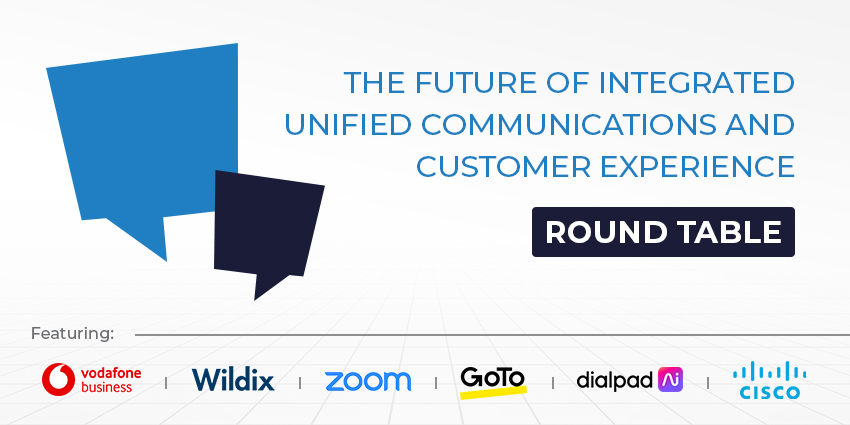As organisations navigate the complexities of digital transformation, the convergence of UC and CX has become a strategic imperative. Seamless integration between communication platforms, AI-driven insights, and customer service tools is reshaping how businesses interact with their clients and teams.
With our latest UC Round Table subject, “The Future of Integrated Unified Communications and Customer Experience”, we spoke with experts and executives from Vodafone Business, Wildix, Dialpad, Zoom, Cisco and GoTo about the trends around the integration of UC and CX tools over the next five years, the biggest challenges businesses face when implementing integrated solutions and how to overcome them, what key innovations will shape integrated solutions moving forward, and how organisations can future-proof their UC and CX estate.
What trends do you envision around the evolving integration of unified communications and customer experience tools over the next five years?

Aahad Khalid, UC & CC Product Lead, Vodafone Business UK
Khalid noted that combining all communication channels for customer interactions (front office) and internal interactions (back office) is becoming increasingly important as businesses wish to provide a best-in-class and consistent customer experience.
“Increased collaboration and faster access to subject matter experts will improve first-time resolution and overall customer satisfaction,” Khalid expanded. “Platforms with built-in integrations and API support will streamline workflows for employees and enable businesses to create efficient customer journeys. The average turnover rate for a call centre is 30–40 percent, but some centres see numbers as high as 100 percent.”
Khalid highlighted that Vodafone Business has partnered with RingCentral to focus on improving the collaboration between UC and CC solutions.
“Integrated solutions mean that businesses can see improvements in employee experience through streamlined workflows and user-friendly AI tools that will make their jobs easier – helping to minimise staff turnover due to big improvements in both colleague and customer communication,” he continued. “Integration doesn’t only improve customer experience, but it reduces license costs too as the calling functionality is available from the existing unified communication service.”
Khalid added that businesses in various industries are looking for a solution that works both in the field and in an office environment.
“For example, front-line workers need to be connected whilst on the go, such as retail staff or agency nurses,” Khalid said. “Therefore, we’re seeing a ‘mobility first’ approach, which allows all types of workers to benefit from using a single mobile app that allows them not only to communicate internally but also with customers to provide comprehensive and timely support, wherever they are.”
“Getting access to real-time conversation data and intelligence across all communications channels is the key to understanding customers,” he continued. “Having a single AI-powered communication platform can offer tools such as real-time call guidance for agents, intelligent virtual agents, AI-generated summaries and AI-based workforce management.”
“This technology not only optimises the customer interaction but also works in the background using machine learning to fine-tune your customers’ experience.”

George Dunn, UKI Collaboration Director at Cisco
Dunn noted that in certain industries, businesses are increasingly leveraging their broader workforce to enhance the overall customer experience. “This doesn’t imply that every employee becomes a ‘power agent,’ but rather that key staff in local stores can support remote customer interactions,” he explained.
“For example, if a customer calls a white goods retailer inquiring about a washing machine, the call can be routed to an expert in the local store who can provide a more personalised response. Modern business telephony now focuses on multi-channel and omni-channel strategies, combining traditional phone systems with UC tools.”
Dunn suggested that this allows businesses to use a single platform for managing calls, messages, and other customer interactions across multiple channels. He affirmed that by integrating these tools, businesses can offer seamless customer experiences, improve communication efficiency, and engage with clients more effectively.
“The role of artificial intelligence is also becoming increasingly important, with AI agents applicable across various sectors to contribute significantly to enhanced customer experiences,” Dunn continued. “Overall, there’s a noticeable transition towards what can be termed ‘Agent UC’ as organisations adapt to these evolving trends to improve customer engagement and service delivery.”
Ben Neo, Head of Customer Experience (CX) Sales EMEA at Zoom
Neo prophesied that over the next five years, NLP is set to undergo a transformative period defined by unmatched innovation and widespread adoption.
“Virtual agents will become more adept at understanding human intent, context, and even subtle emotional cues,” Neo expounded. “However, rather than replacing human interaction, these advancements in AI will empower people by serving as collaborative partners.
“Personalised AI agents will become commonplace, acting as digital companions tailored to individuals’ specific needs, preferences, and goals. These agents will go beyond managing schedules; they will understand unique communication styles, anticipate needs, and collaborate seamlessly with other AI systems.”
At the organisational level, Neo asserted that AI agents will evolve from automating tasks to orchestrating actionable insights across entire operations. “They will identify inefficiencies, optimise workflows, and ensure high-priority actions are addressed in real time,” he added. “This shift will enable businesses to operate with unprecedented agility and precision.”
Damon Covey, General Manager, UCaaS at GoTo
Covey asserted that as unified communications and customer experience tools integrate, AI will become both the expectation and the norm.
“As AI becomes an embedded feature through continued integration, it should be prioritised in a conversational capacity to enhance customer communications,” Covey said. “Customers of all sizes will realise and demand the same level of service and functionality that only large customers enjoy today, and companies need to prepare accordingly.”
Natala Menezes, VP of Product Marketing at Dialpad
Menezes said that deeper data integration will drive UC and CX tool integration over the next five years.
“The convergence of UC and CRM platforms will allow businesses to unify customer and employee data, creating seamless interactions and personalised experiences,” Menezes elaborated. “Analytics will play a pivotal role, providing real-time insights that enhance decision-making and operational efficiency.”
She added that the employee experience will also take centre stage, with tools designed to streamline workflows and boost productivity, ensuring employees can deliver exceptional customer service.
“As video and voice become nearly indistinguishable daily, businesses will adopt these tools interchangeably, further enhancing collaboration and engagement,” Menezes expanded.
“Additionally, the concept of being ‘channel-less’ will continue to evolve. Customers and employees will navigate effortlessly across voice, video, chat, or email channels without perceiving boundaries. By 2030, this seamless experience will redefine how businesses communicate and connect with their customers.”
Steve Osler, CEO of Wildix
Osler noted that the integration of unified communications and customer experience tools is moving toward an “omniscient approach, where every interaction—whether by email, chat, video call, or in-person, connects seamlessly into one unified system”. This ensures interactions feel intuitive and personal, fostering trust and continuity.
“As customers grow more impatient in an era of instant gratification, they expect quick, efficient responses that respect their time,” he added. “Businesses adopting this approach can anticipate and resolve issues proactively, delivering smooth, human-centred experiences.”
Another critical shift Osler highlighted is the emphasis on meaningful, connected customer journeys.
“Consumers increasingly demand service on their terms, fast, accessible and free of frustrating back-and-forths,” Osler said. “By bridging gaps between teams and systems, unified communications help businesses meet customers where they are, creating interactions that are natural, efficient and valuable, ultimately building stronger, lasting relationships.”
What are the biggest challenges businesses face when implementing integrated UC solutions, and how can they overcome them?

Steve Osler, CEO of Wildix
Osler suggested the biggest challenges in adopting integrated UC solutions are adapting to change, ensuring security, and keeping things simple.
“These are fundamentally about people, not just technology,” Osler explained. “Change can be uncomfortable, as new tools disrupt familiar routines. Overcoming this requires patience and education: start small, showcase quick wins, and help people see how the tools make their work easier and more efficient.”
Osler added that security is another key concern, especially when handling sensitive data. “Trust is earned through transparency and the best systems make security feel seamless, integrated from the start, not added later,” he expanded. “Finally, simplicity is critical. Even the most powerful tools fail if they’re too complex.”
“When technology is intuitive, people use it naturally, making it a valuable part of their work. Ultimately, the goal is to create solutions that empower people, safeguard their trust and integrate smoothly into their lives, making work simpler, safer and more connected.”

Damon Covey, General Manager, UCaaS at GoTo
Covey outlined that one of the biggest challenges businesses face when integrating UC solutions is making them congruent with their existing tech stack solutions, such as CRMs and ERP platforms.
“To overcome these challenges, businesses can select offerings that already have sustainable, scalable integrations in place, with the capacity to grow alongside users and meet evolving needs,” he suggested.
Aahad Khalid, UC & CC Product Lead, Vodafone Business UK
Khalid suggested that integrations can be done in two main ways.
“Firstly, businesses can utilise ‘out of the box’ UC plug-ins that are pre-integrated into your existing business applications,” he explained. “Secondly, businesses can leverage an open platform’s APIs to create a customised solution that integrates with your existing business applications.”
The main challenge Khalid sees is the technical integration of an organisation’s UC solutions with its current and future business applications. “To overcome this, it’s really important to carefully choose your technology partner, as you may need a platform that supports both out of the box and open-source integrations,” he added.
Khalid also stressed the importance of partnering with someone who can offer expertise in integration so they can handle any complexities. “More specifically, the right partner can help with building proof of concepts, testing integrations, providing service management and change management to ensure your integrated solution works for your business,” Khalid highlighted.
“At Vodafone Business, we have been providing connectivity and a service wrap to businesses of all sizes for over 40 years. We have created a customisable service support model that allows you to pick and choose enhanced levels of care, allowing you to overcome support challenges when you are building a next-generation integrated unified communications and contact centre solution.”
Ben Neo, Head of Customer Experience (CX) Sales EMEA at Zoom
Neo highlighted that one of the initial hurdles is the complexity of getting started.
“It is crucial to assess your business strategy and determine whether a single-platform solution aligns with your needs,” Neo said. “In many cases, a more flexible and integrated approach may be a better fit.”
Another common challenge Neo cited is business leaders’ reluctance to move away from legacy systems due to concerns about costs, potential disruptions, and reliance on familiar workflows. However, Neo expanded that these systems often lack the scalability, flexibility, and advanced capabilities needed to meet modern business demands.
“To overcome this, organisations should adopt a phased transition plan supported by comprehensive employee training,” Neo offered. “Partnering with experienced platform providers can further facilitate a smooth implementation. These providers can offer education and help identify key use cases, building the confidence businesses need to deploy these services more broadly across the organisation.”
George Dunn, UKI Collaboration Director at Cisco
Dunn emphasises that the biggest challenges businesses face when implementing integrated UC solutions include migrating from their current systems to their desired state and ensuring user adoption to maximise the platform’s potential.
“One of the most significant hurdles is addressing interoperability and openness, especially as many community-based systems have shifted from protocol-level integrations to APIs, with varying levels of openness among different systems,” Dunn said.
“To overcome these challenges, it is crucial to plan the user journey thoroughly and avoid relying solely on bundled or free solutions, as these options may not meet the business’s specific needs or could lead to unexpected costs in the long run.”
Natala Menezes, VP of Product Marketing at Dialpad
Menezes highlighted that implementing integrated UC solutions poses several challenges, particularly regarding legacy system integration.
“Many businesses struggle with migrating from outdated PBX systems and siloed communication platforms, which often involves complex transitions and significant downtime risks,” Menezes said. “Additionally, data trapped in outdated formats and systems and incompatible protocols and standards can hinder seamless integration.”
Another critical challenge Menezes pinpoints is change management. She asserts that upgrading to UC solutions requires a balanced focus on people, processes, and systems. Without a comprehensive plan to address user adoption, training, and workflow adjustments, organisations may encounter resistance or inefficiencies.
“Compliance and security further complicate the process,” she continued. “Businesses must establish clear policies and robust systems to ensure data security, privacy, and adherence to industry regulations. To overcome these challenges, organisations should adopt a phased migration approach, invest in tools and expertise for seamless integration, and develop a thorough change management plan to align people and processes with the new technology.”
What key technologies or innovations (e.g., AI, 5G, IoT) do you think will play the biggest role in shaping integrated UC and CX solutions?
 Natala Menezes, VP of Product Marketing at Dialpad
Natala Menezes, VP of Product Marketing at Dialpad
Menezes outlined that AI is already revolutionising customer experiences through chatbots, virtual assistants, and personalised recommendations.
“Within integrated UC and CX, AI enhances efficiency by automating tasks such as call routing and scheduling while providing real-time sentiment analysis during interactions,” she said. “It also generates actionable insights from customer data to improve service and personalisation further and leverages predictive analytics to anticipate needs and proactively address issues.”
Menezes emphasised that NLP is another game-changer. “It enables real-time sentiment analysis, personalises interactions based on customer preferences, and seamlessly translates languages to support global communication,” she continued. “Advanced analytics and machine learning further elevate this technology by identifying behavioural patterns, predicting future needs, and personalising offers.”
“Together with faster 5G connectivity and IoT-driven insights, these technologies will enable businesses to deliver more responsive, tailored, and efficient communication experiences.”
George Dunn, UKI Collaboration Director at Cisco
Dunn underlined AI’s potential to revolutionise customer CX by transforming interactions across multiple channels, from personal assistants to AI agents and augmented live agents, streamlining tasks and enhancing efficiency.
“Key innovations like AI-driven data analytics are reshaping how businesses engage with customers, offering new ways to analyse large unstructured data sets and integrate insights from IoT devices,” Dunn said. “Emerging technologies like augmented reality (AR) and virtual reality (VR) are also set to gain traction, as they are now available in consumer products like virtual reality headsets, further enhancing CX in innovative ways.”
Aahad Khalid, UC & CC Product Lead, Vodafone Business UK
Khalid understandably pinpoints AI as the technology that will have the most profound effect on shaping integrated UC and CX solutions.
“The possibilities and benefits of AI are still being discovered daily,” Khalid asserted. “It’s an exciting time for technology. Our Vodafone Business UC with RingCentral platform now has the addition of RingCXTM, which allows customers to use AI to improve their operations and provide a better customer experience.”
“Agent performance is a key area where AI can be leveraged to create efficiency gains. Agents can benefit from real-time AI assistance and script guidance, providing them with live coaching on every call. This has helped to improve engagement by up to 63 percent and reduce agent attrition by up to 45 percent.”
Khalid also emphasised that while on the phone, AI can generate real-time transcription to help them improve engagement during customer conversations. When the call finishes, AI can also help generate call summaries and save 35 percent of post-call work time by freeing them from taking notes or capturing action items.
“AI can also support workforce management, supporting businesses to optimise resource costs and agent schedules, and ensuring there is the right mix of agents and skills,” Khalid continued. “AI-driven forecasting means customers aren’t left waiting during peak times and agents aren’t idle during quiet times.”
Khalid also observed that IoT and 5G are also a key part of the development.
“Businesses want to use omnichannel platforms to process all data, including recordings and transcripts, in one place after gathering it from multiple places, such as IoT devices,” Khalid said. “IoT devices generate data from sensors and machines at various frequencies; for example, a smart meter may send information once a day, whereas an EV charging point could share information every minute or even quicker depending on whether it’s in use.”
Khalid emphasised that AI is crucial for transforming all data into a human-readable format. AI will help businesses handle large amounts of data gathered from all channels and devices and allow them to focus on discovering insights, improving processes, and gaining a competitive advantage.
“On top of this, the integration of 5G technology will further improve IoT and AI,” Khalid outlined. “With its high-speed connectivity, low latency, and increased capacity, 5G will facilitate real-time data transmission and processing from devices in the field.”
“This means more efficient data collection and analysis, allowing businesses to respond quickly to changing conditions and customer needs. The combination of IoT, AI, and 5G technology will be pivotal in driving innovation and helping businesses to maintain their competitive edge in the market.”
Steve Osler, CEO of Wildix
Osler suggested the future of integrated UC and CX will be shaped by tools that make communication faster, easier and more personal.
“AI will help tailor interactions in real time, while automation handles repetitive tasks so teams can focus on what matters most,” he said. “Edge computing will ensure faster, smoother experiences by processing data locally, and AR/VR will bring new ways to train, collaborate and support customers.”
“Even technologies like blockchain will add value by keeping data secure and transparent. But the real value lies in how businesses use these technologies to bridge gaps, eliminate inefficiencies and build trust.”
Damon Covey, General Manager, UCaaS at GoTo
Covey pinpoints conversational AI as a differentiator for how businesses operate as it becomes further embedded in UC and CX solutions. “As it matures and gains public trust, organisations can ramp up the tech’s role in addressing requests and responding to customer communications,” Covey added.
Ben Neo, Head of Customer Experience (CX) Sales EMEA at Zoom
Neo highlighted that AI and machine learning tools are advancing rapidly and are poised to become foundational components of integrated UC and CX platforms. He stressed that these innovations will enable more personalised experiences for both customers and employees. “For instance, many organisations are already utilising AI-driven bot builders to develop self-service tools for employees via UCaaS,” Neo said.
“Additionally, AI expert assist functionality is enhancing customer interactions by providing agents with proactive and contextual suggestions during engagements and automating post-call tasks, processes that would otherwise take considerable time for agents to complete. This automation has already resulted in up to a 50 percent reduction in agent time spent on customer engagements.”
Neo also outlined that advanced AI solutions will increasingly be embedded into these platforms to deliver deeper business insights.
“Organisations will use these tools to analyse how employee behaviours and user experiences affect customer satisfaction, creating opportunities to optimise workflows and enhance service delivery,” Neo said. “Additionally, AI-powered analytics will support strategic decision-making and planning, enabling companies to remain agile and competitive.”
“The rollout of 5G will further amplify the capabilities of UC and CX solutions by providing faster, more reliable connectivity, which is crucial for real-time communication and data processing.”
With the rapid pace of technological change, how can organizations future-proof their UC and CX investments to remain competitive?

Ben Neo, Head of Customer Experience (CX) Sales EMEA at Zoom
Firstly, Neo suggested that organisations must align technology investments with their business objectives. AI and other technology initiatives should be directly tied to clear business goals. “By defining their purpose, expected outcomes, and measurable benefits, businesses can secure internal buy-in and maintain a sharp focus on delivering value,” he elaborated.
Next, Neo stated that prioritising human oversight is essential. “Establishing guidelines for the responsible use of AI, along with ongoing monitoring and evaluation, ensures the technology produces accurate and ethical results.”
Neo continued: “Future-proofing UC and CX solutions begins with building adaptable AI architectures. Designing scalable and flexible systems from the outset allows organisations to accommodate evolving demands and capabilities, minimising the need for costly rework in the future.”
“Finally, the successful adoption of new technologies relies on strong change management practices. Engaging employees at every stage, addressing ethical and privacy concerns, and ensuring leaders champion innovation adoption are critical to achieving long-term success.”
Damon Covey, General Manager, UCaaS at GoTo
For organisations to remain competitive and future-proof their UC and CX investments, Covey emphasised that they must choose a vendor that uses industry standard and non-proprietary LLM technology.
“Ensuring that their feature sets have healthy and robust roadmaps for future innovation is also essential, guaranteeing that features are accessible and readily available when needed.”
Steve Osler, CEO of Wildix
Osler asserted that future-proofing isn’t about chasing every new trend but about building systems that are adaptable, simple and built for people.
“Businesses need tools that adapt as they grow, with open platforms that welcome change instead of resisting it,” Osler said. “Simplicity is non-negotiable. Intuitive tools are the ones teams actually use. But the real secret is investing in people. Train them, empower them and give them the confidence to embrace new ways of working.”
Natala Menezes, VP of Product Marketing at Dialpad
Menezes stressed that organisations must adopt a proactive and strategic approach to future-proof UC and CX investments.
“Investing in AI now is critical as it continues to transform communication and customer experience,” Menezes clarified. “Partnering with vendors who have in-house expertise and native AI capabilities ensures access to cutting-edge tools and ongoing innovation.”
“Equally important is embracing change with a forward-thinking mindset. This involves fostering empathy for customers and employees, understanding their needs, and adapting solutions to enhance their experiences. Empathy-driven strategies build trust and loyalty while ensuring technology effectively serves its users.”
Menezes also underscored the importance of a clean and organised data stack. “Unified and accurate data enables AI and analytics tools to deliver actionable insights, improving operations and customer satisfaction,” she said.
“Organisations can remain competitive, adapt to technological advancements, and continue delivering exceptional UC and CX solutions by staying agile, prioritising AI, and maintaining robust data foundations.”
Aahad Khalid, UC & CC Product Lead, Vodafone Business UK
Khalid expressed that products are constantly innovating and evolving, and it can be overwhelming, especially if UC & CC integration is new to your organisation. “It’s really important to choose the right technology partner and the right solution, so take your time as this will impact the success of your deployment,” Khalid said.
He outlined three strategies for future-proofing the estate, including using “a specialist technology partner who can provide a platform that is suited to your needs, leverage their expertise in deployment, and ensure that your employees are adequately trained on the new solution”.
Khalid also suggested “thinking holistically about what business applications are key to delivering an exceptional customer experience and, ultimately, success for your business. Ask yourself, ‘Do these applications need to directly integrate with your customer experience platform?'”
Lastly, “Map out your customer’s journeys and look for efficiency gains, in particular journeys that require assistance from ‘back office’ employees. Ask yourself, ‘How can integration make this a more efficient process for customers?’”
George Dunn, UKI Collaboration Director at Cisco
Dunn proffered that organisations should consider migrating to cloud or SaaS solutions to future-proof their UC and CX investments and benefit from continuous innovation in the face of rapid technological change.
“It’s also important to minimise the risk of vendor lock-in and avoid those that incorporate hidden co ts and complexities,” Dunn said. “For larger companies, it will also be worth exploring how they can invest in their own integrations and customisations by leveraging APIs effectively to retain their all-important competitive edge.”







